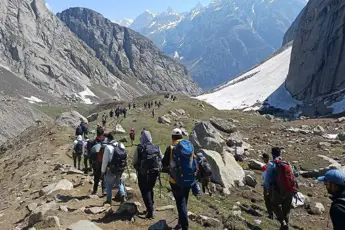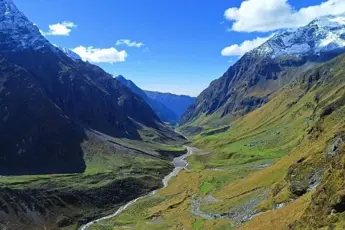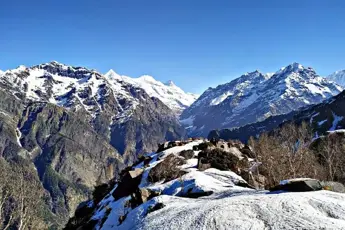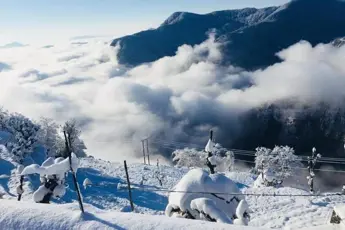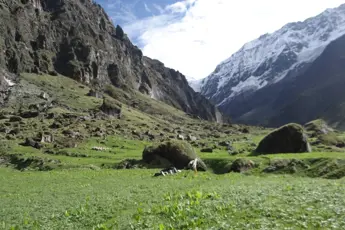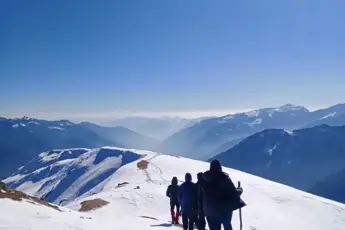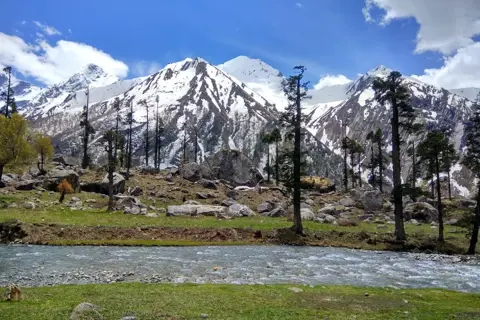
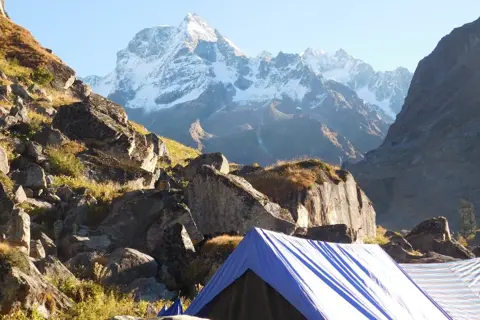
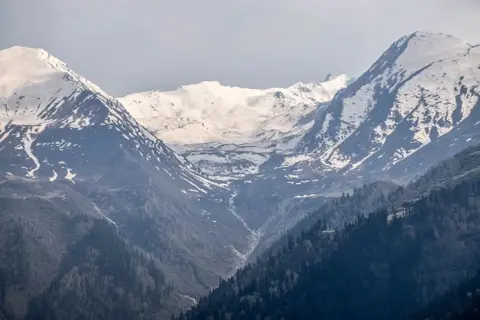
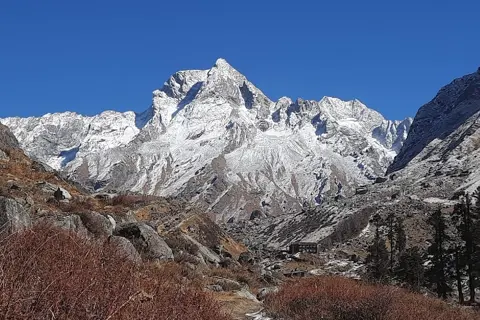
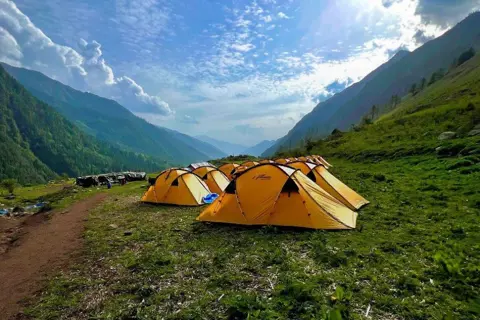
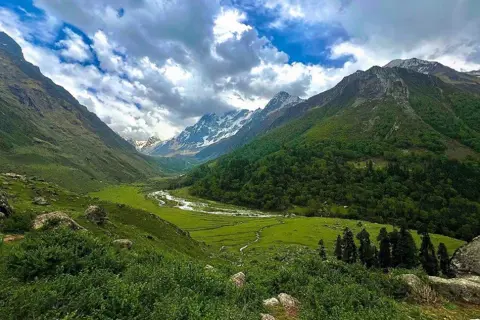
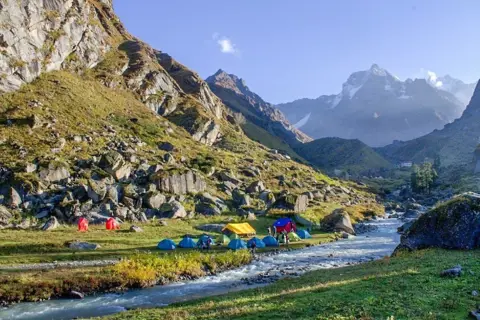

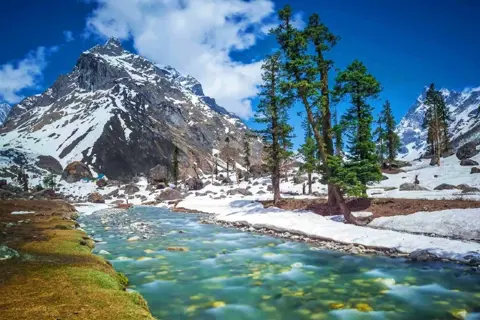
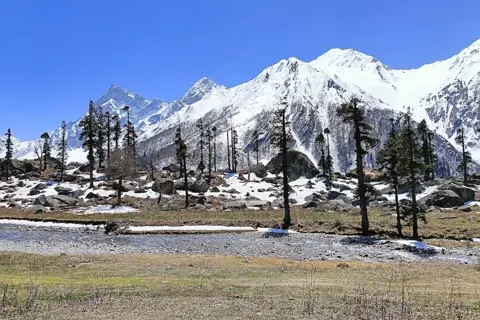
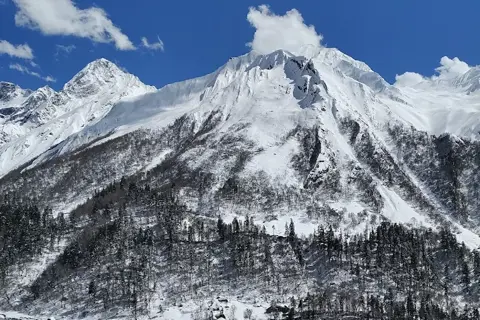

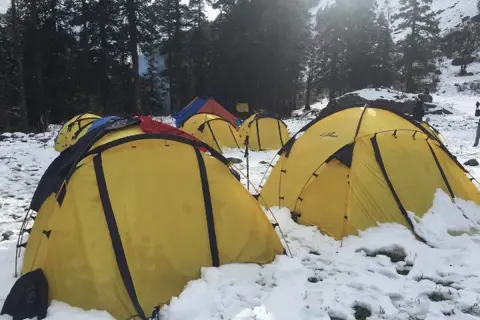
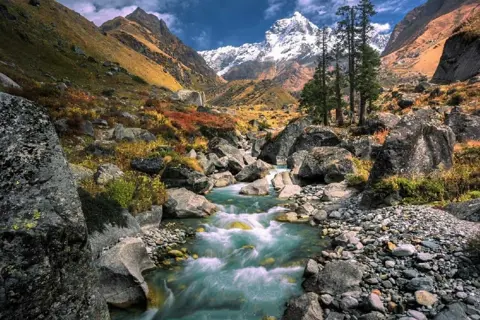
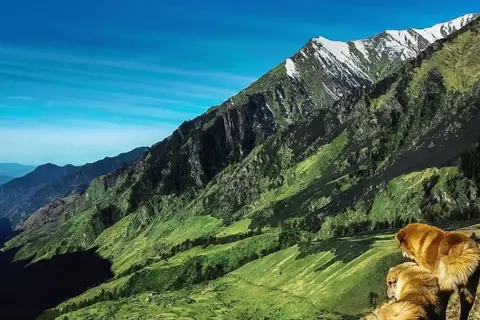



Images


Images
Har Ki Dun Trek
Starting from INR 15712
Per Person
( Inclusive of all taxes )
Meal
Permit
Trekking
Guide
Campfire
Tent Stay
Tea Snacks
Dormitory Stay
Meal
Permit
Trekking
Guide
Campfire
Tent Stay
Tea Snacks
Dormitory Stay
Har Ki Dun Trek: Highlights
Har Ki Dun, also known as the Valley of Gods, offers breathtaking views of snow-capped peaks, lush green meadows, and beautiful alpine forests.Har Ki Dun is believed to be the same route taken by the Pandavas from the Mahabharata on their journey to heaven.The mythological connection gives the trek a spiritual touch, with ancient temples and local legends adding to the experience.You may encounter wildlife such as Himalayan Monal, black bears, and even snow leopards in the higher regions of the trek.If you're lucky, you may encounter wildlife such as Himalayan Monal, black bears, and even snow leopards in the higher regions.The Har Ki Dun trek is ideal for beginners and intermediate trekkers, featuring a trail that isn’t too steep and offers ample time for acclimatization.Despite its accessibility, the trek includes rocky paths that add a touch of adventure to your journey.Spend nights camping in a stunning valley, surrounded by towering mountains and starry skies, offering a serene escape from city life.Enjoy cosy evenings by the bonfire, making it a perfect getaway to unwind and connect with nature.
Har Ki Dun Trek: Overview
Activity location: Uttarkashi, UttarakhandTrip Duration: 7 Days | 6 NightsMax. Altitude: 12,000 Ft.Har Ki Dun Trek Distance: 47 Km.Best Time to Visit: April- November.Har Ki Dun Trek Difficulty: Easy to Moderate.Accommodation: Stay in a guesthouse/homestay/ Swiss tents/ dome tents during the trek as per the sharing pattern/occupancy opted.Meals: All meals from your arrival to departure from the base camp are included (Morning Tea, Breakfast, Lunch, Hi-Tea with Snacks, and Dinner). We provide simple, nutritious yet tasty vegetarian meals on all trek days.About Har Ki Dun Trek, Uttarakhand:The Har Ki Dun Trek, often called the "Valley of Gods," is a stunning trekking destination in the Western Garhwal region of Uttarakhand, India. Known for its breathtaking scenery and pristine landscapes, this trek is a perfect blend of adventure, natural beauty, and cultural richness. The trek takes you through ancient villages, lush meadows, and dense forests, offering a glimpse into the enchanting wilderness of the Himalayas. Har Ki Dun trek is among the most sought-after treks in the Garhwal Himalayas and to an extent a very endearing one. 'Har-ki-dun' in layman's language means the Valley of Gods and can be compared to a cradle of nature which offers some amazing and unique flora and fauna. Snow-capped mountains enclose the valley, and the valley itself is immersed in snow during winters, therefore, making the heavy snow-laden trails inaccessible to the public. Hence, the best time for Har ki Dun trek starts in the spring of March until late June. Then the monsoon arrives, shutting down the Govind Pashu Vihar Sanctuary for about 3 months. Trekking resumes in September continuing til mid-January of next year. Har ki Dun is a fraction of the very nature-rich Govind Wildlife Sanctuary. It is located at an altitude of 3,566 m or (11,700 ft.), offering a panoramic view of peaks such as Swargarohini, Bandarpoonch, and Black Peak.Trending Packages: Bali Pass Trek | Kashmir Great Lakes Trek | Gaumukh Tapovan Trek | Brahmatal Trek | Kedarkantha Trek
Inclusion and Exclusion
This Package Includes:TrekkingTrekking equipment - High-quality tents, sleeping bags, ice axes, ropes, micro spikes, gaiters, etc.Professional Trek LeaderSafety equipment - First aid medical kits, oxygen cylinders, etc. will be available at all campsites to deal with emergencies.Permission ChargesMealsTea/CoffeeAccommodationExcludes:Anything not specified in the Inclusions sectionAdditional Meals unless specifiedTransport unless specifiedAirfare / Train/ Bus TicketsTravel InsuranceAdditional expenditure and Extra Services if takenAny expense incurred or loss caused byflight delays /rescheduling/cancellations, any accidents/ medical evacuations, riots/strikes/war/pandemic, etc.
Tour Plan
Dehradun to Sankri
Drive from Dehradun to Sankri (1950 m)Distance Covered: 197 km from Dehradun to SankriDuration: 9-10 hours to reach SankriKey Details:Start your journey from Dehradun (if you've opted for transportation by Bikat Adventures, board at ISBT Dehradun by 7 AM).Travel through Mussoorie and Kempty Falls.Enjoy a scenic drive along mountain streams and through blue pine forests after Mussoorie.Pass by the Yamuna River along the way.The last 22 km stretch to Sankri passes through the Govind National Park, with views of exotic flora, fauna, and apple orchards.Expect rough roads but stunning views of the Tons River valley and dense conifer forests.Arrive at Sankri by 5 PM. It offers scenic views of Mt. Swargarohini, especially at sunset.During the winter season (December to February), snow starts from Sankri itself.Stay: Overnight in guest houses. After check-in, explore the surrounding areas.
Sankri to Pauni Garaat
Sankri (1950 m) to Pauni Garaat (2500 m) via Taluka (2108 m)Start Point: Sankri (1950 m)Mode of Transport: Road journey to TalukaDistance: 12 km by roadDuration: 1 hourHighlights:Drive through Deodar and Bamboo forestSpot Himalayan birds: Himalayan Raven, Red-Billed Blue Magpie, Himalayan BulbulClear water streams alongside the roadArrival at Taluka (2108 m)Description: Small hamlet with concrete houses and government guest housesLandmark: Supin River flowing through the villageBreak: Short refreshment stopTrek from Taluka to Pauni Garaat (2500 m)Distance: 9 km trekDuration: 5-6 hoursTrail: Uneven, stony trail at the beginningOpens to a level walk along the banks of the Supin RiverWalk through lush coniferous forests (Walnut, Pine, Cedar trees)Easy gradient with gradual ascentsScenic mule-traffic and local villagersBridges: Cemented and wooden bridges over streams (ideal for water refills)Midpoint: Gangar VillageLocation: Other side of the Supin RiverStop for Lunch: Packed lunch with tea and snacks available at wooden shopsFinal Stretch to Pauni GaraatRoute: Follow the trail running alongside potato and maize fieldsCampsite: Pauni Garaat (vast clearing; village located on the other side of the river)At the Campsite:Set up camps, explore the area, and enjoy a hot dinnerRest early in preparation for the next day’s journey
Pauni Garaat to Simatra
Pauni Garaat (2500 m) to Simatra (3024 m):Distance Covered: 8 km from Pauni Garaat to KalkattiyadhaarDuration: 3-4 hours to reach SimatraStart the Day: Begin with a short yoga and stretching session.Enjoy breakfast before starting the trek.Trek Begins:The 8 km trek starts through a forested trail.Pass through Seema village, marked by concrete structures and a forest department guest house near the Supin River.View Osla village on the opposite side of the Supin River, 100 meters higher in elevation.Seema Bridge:Cross the iconic Seema Bridge, a hanging bridge over the Supin River with a backdrop of mountain ranges.Spot the jewel-blue Supin River flowing between boulders.Steep Climb:After crossing the bridge, prepare for a steep ascent.Pass expansive Amaranth fields where villagers work. During the monsoon, the fields turn a deep reddish colour.Enjoy stunning views of the snow-capped Banderpoonch and Swargarohini ranges after about half an hour.Trail to Simatra:Gradually climb higher past fields, with the Supin River fading from view.Trek through stretches with beautiful views of the Dhauladhar ranges.Pass flowers like fleece and sunflowers along the trail.Arrive at Simatra:The trail culminates at a ridge known locally as Simatra.A short descent leads to the Simatra campsite.Expect to reach the campsite by 1 PM.Simatra Campsite:The campsite is a stunning open meadow with views of peaks like Buyal Devsu and Mt. Black Peak.Spot the Ruinsara Range on the left and Kedarkantha Summit on the right.Enjoy the afternoon basking in the sun, taking in the valley views.Use the extra time to acclimatize to the altitude and prepare for the upcoming summit.
Simatra to Har Ki Dun
Simatra (3024 M) to Har Ki Dun (3566 M) and back to SimatraDistance Covered: 14 km (7 km each way)Duration: 7-8 hours round tripEarly Start: Start Time: 6 AM (post-breakfast).Begin your trek as the sun rises.Snow Gear:In December, you may encounter snow-covered trails.Trek Leader: May provide microspikes and gaiters for easy navigation.Initial Trail:The trail runs high above the convergence of the Supin River and the river from Ruinsara Valley.Views: Sprawling views of snow-clad peaks, including Black Peak in the Ruinsara Valley.Trek Gradient:Gradient: Moderate with a mixture of steep and gradual ascends.Includes a stretch with an incline of about 45 degrees, possibly covered in knee-deep snow.Final Ascent to the Summit:Climb alongside a river through a dense forest.Har Ki Dun Summit: Opening up to breathtaking views of Swaragrohini-1 Peak, Hata Peak, and Black Peak.Explore Har Ki Dun:Meadows with alpine flowers, glacier moraines, coniferous forests, and mountain ranges.Exploration Time: 1-2 hours.Lunch and Return:After exploring, enjoy lunch and head back to Simatra.
Simatra to Pauni Garaat Trek
Simatra (3024m) to Pauni Garaat (2500m)Distance Covered: 7 kmDuration: 3-4 hours to reach Pauni GaraatMorning at Simatra:Wake up early to catch a stunning sunrise from the Simatra campsite.Morning temperatures can drop to subzero levels in December, so dress warmly.Start of Trek:Have breakfast before starting the trek.Begin the descent by crossing the Har Ki Dun Bridge.Trek Details:The trail is mostly downhill, making the trek easier.Gentle descent downstream after crossing the bridge.Ascend slightly to Simatra, followed by a gradual descent toward Pauni Garaat.Exploring Osla Village:On the way, visit Osla Village, a quaint mountain village.Observe double-storied wooden houses with slanting roofs.Visit the Someshwar Temple, dedicated to Lord Shiva, featuring intricate carvings.Interaction with Locals:If time permits, interact with the locals, known for their friendliness towards trekkers.Arrival at Pauni Garaat:After exploring, descend to Pauni Garaat.Spend the night at Pauni Garaat campsite.
Pauni Garaat to Sankri Trek
Day 1: Trek from Pauni Garaat (2500 m) to Taluka (2108 m); Taluka to Sankri (1950 m) by roadDistance Covered:12 km trek from Pauni Garaat to Taluka12 km from Taluka to Sankri by roadDuration:5-6 hours to reach Taluka1 hour to reach SankriHighlights:After breakfast, begin the descent from Pauni Garaat to Taluka.Trek through thick forests of Chir Pine, ferns, and flowering trees.Caution: "Bichu ghaas" (nettles) along the trail; avoid contact to prevent a stinging sensation.Descending throughout the day; trekking poles are recommended to reduce strain on knees.Walk alongside the Supin River for a portion of the trek.The final stretch is a cemented trail leading to Taluka.The vehicle will be waiting at Taluka for the road journey to Sankri.Arrive in Sankri in time to relax and enjoy tea while reflecting on the trek.Day 2: Sankri (1950 m) to Dehradun (640 m)Distance Covered: 197 km by road from Sankri to Dehradun.Duration: 9-10 hours to reach Dehradun.Highlights:After breakfast, enjoy the scenic views around Sankri.Begin the drive back to Dehradun, retracing the roads from the first day.Expected arrival in Dehradun by 7-8 PM.
Package Variant Options
Har Ki Dun Trek without Transportation
Things To Carry
Clothing:Thermal wear (top and bottom)Fleece jacket or woollen sweaterWaterproof and windproof jacketTrekking pantsT-shirts (quick-dry)Warm gloves and socksWoollen cap and sun hatFootwear:Sturdy trekking shoesComfortable sandals or flip-flops (for evenings)Extra pair of socksAccessories:Sunglasses (UV protection)Sunscreen lotion and lip balm (SPF 30+)Trekking polesBackpack (50-55 liters) and rain coverRaincoatHeadlamp or flashlight with extra batteriesPersonal Items:Toiletries (toothbrush, toothpaste, soap, towel, etc.)Personal medication and first-aid kitWater bottle or hydration packHigh-energy snacks (nuts, energy bars, etc.)Others:Camera and extra batteriesMobile phone and power bankLightweight sleeping bag (optional)Plastic bags or waterproof bags for storing wet clothesIdentification documents Pack wisely to ensure a comfortable and enjoyable trekking experience.
Starting from INR 15712
Per Person
( Inclusive of all taxes )
Enquiry Form
Why escape2explore
done Verified Google Reviews 5000+ Reviews on the google platform.done 500+ Tours and Activities We have activities across every category so that you never miss best things to do anywhere.done Customer Delight We are always able to support you so that you have a hassle free experience.
Reviews (53)
4.7
Out of 5.0
5
41
4
10
3
1
2
0
1
0

Aishu
Reviewed: Dec 4, 2023
5/5
Just completed the Har Ki Dun trek with Escape2Explore. The trek's difficulty level was perfect for me—challenging, yet achievable. The Har Ki Dun trek itinerary was well-designed, and the location... Read More
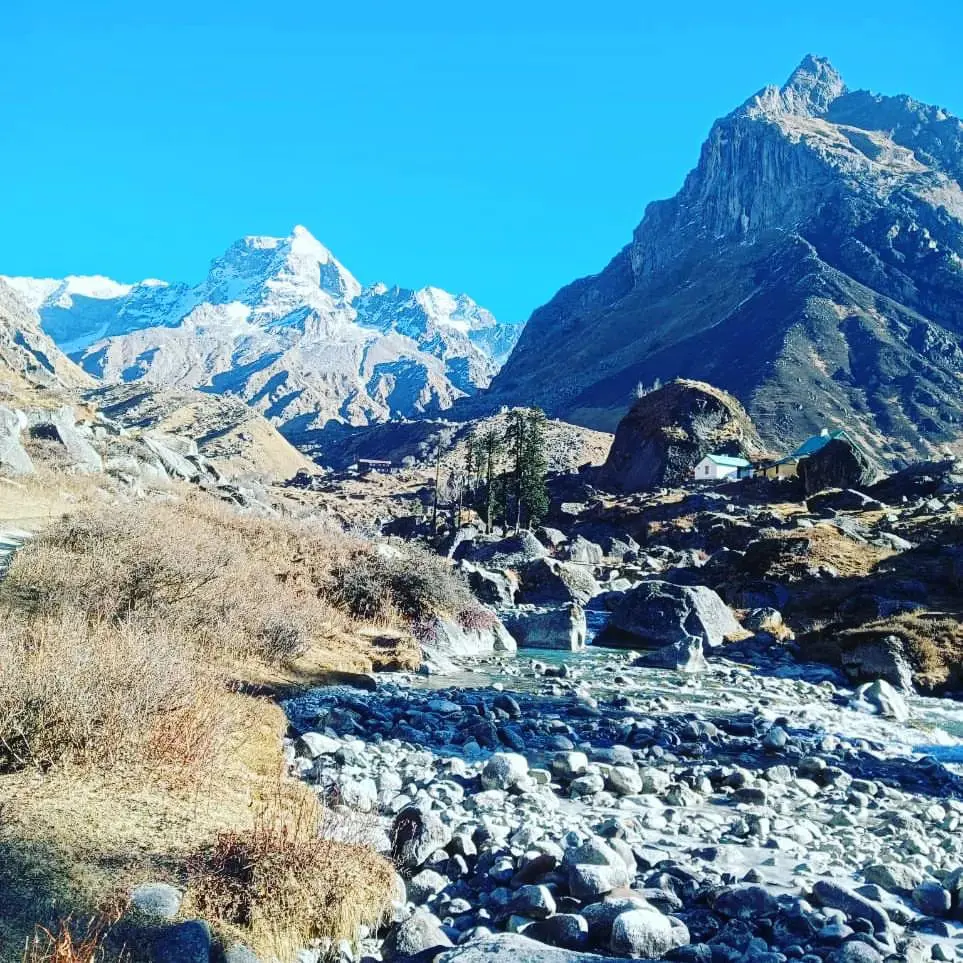


Devi
Reviewed: Dec 4, 2023
5/5
I recently completed the Har Ki Dun trek with Escape2Explore, and it was truly an unforgettable experience. From the moment I signed up, I knew I was in good hands.... Read More



Radika
Reviewed: Dec 4, 2023
5/5
Had an amazing time on the Har Ki Dun trek with Escape2Explore. The Har Ki Dun trek itinerary allowed us to explore some of the most beautiful parts of the... Read More

Moni
Reviewed: Nov 21, 2023
5/5
The Har Ki Dun trek itinerary was well-thought-out and the trek was full of amazing views. I appreciated the moderate Har Ki Dun trek difficulty level—not too easy, but not... Read More

Kushi
Reviewed: Nov 20, 2023
5/5
I had an unforgettable experience on the Har Ki Dun trek with Escape2Explore. The trek is a perfect blend of natural beauty and adventure. The Har Ki Dun trek location... Read More
Related Packages
Frequently Asked Questions
Q1: What is special about Har Ki Dun Trek?
One of Uttarakhand’s most scenic treks, it features lush green valleys, glacial rivers, alpine forests, and historic villages, making it a paradise for nature lovers and adventure seekers.
Q2: What is the altitude of Har Ki Dun?
Har Ki Dun valley is situated at 3,566 meters (11,700 feet), offering breathtaking views of the Swargarohini peaks and surrounding landscapes.
Q3: Is this trek suitable for beginners?
Yes, it is a moderate-level trek, suitable for beginners and experienced trekkers, though good fitness is required due to long trekking hours.
Q4: What is the duration of the trek?
The trek usually takes 7 days, including travel to and from Sankri, covering scenic trails and remote Himalayan villages.
Q5: What is the best time to visit Har Ki Dun?
The best seasons are April-June (spring/summer) for greenery and September-November (autumn) for clear mountain views.
Q6: Are there any religious or mythological connections?
Yes, according to Hindu mythology, the Pandavas took this route to reach heaven, making it a spiritually significant trek.
Q7: What kind of accommodation is available on the trek?
Camping is essential, but some forest guesthouses are available at villages like Osla, providing basic shelter.
Q8: Are there any river crossings on this trek?
Yes, trekkers cross wooden bridges over glacial rivers, making the journey both scenic and adventurous.
Q9: What are the biggest challenges on this trek?
Long trekking hours, river crossings, and unpredictable weather can be physically demanding for some trekkers.
Q10: Is there a mobile network on the trek?
No network connectivity beyond Sankri, so it’s best to inform family and carry offline maps.
Q11: What kind of wildlife can be spotted?
Trekkers may see Himalayan black bears, langurs, musk deer, and rare birds in the Govind Wildlife Sanctuary.
Q12: I am a solo traveller, can I join the Har Ki Dun Trek?
Yes, you can join the trek to Har Ki Dun. The trek’s difficulty level is moderate and can be attained without someone’s support. Wear robust footwear, and comfortable clothes, and maintain basic fitness to complete the trek.
Q13: Har Ki Dun trek is safe for females
The safety and security of women/girls are paramount to us. Hence, it's entirely safe for women/girls to participate in our treks and travels. Our trek leaders always accompany the group, offering constant assistance and direction. Our campsites are thoroughly secure and provide a safe lodging environment. In addition, our female trek leaders often join our treks.
Q14: What will happen if the Har Ki Dun trek does not go through?
Your money will be refunded within 2-3 business days.
Q15: Can I reschedule my Har Ki Dun trek to a future date if I am unable to attend on the day of departure?
Unfortunately, it's not feasible to reschedule your trek to a future date if you're unable to attend on the designated day, regardless of the circumstances (like family emergencies, health problems, or work commitments). However, if you have concerns about this policy, please don't hesitate to email us at info@escape2explore.com, and our team will get in touch with you to discuss further.
Cancellation Policy
Life is unpredictable and we understand that sometimes you have to cancel or change your trip dates and we endeavour to make it as easy as possible for you. However, please understand that we plan everything including guide fees, permits, accommodation and ration. Therefore, any cancellation means inconvenience and certain losses to the people involved in various stages of the programme. Keeping that in mind, our cancellation charges are as below -Cancellations before 30 days from the start of the event: Get a monetary refund with 15% of cancellation charges.Cancellations between 30 days and 15 days to the start of the event: 50 %refund.Cancellations less than 15 days to the start of the event: No refund.Cancellations will be accepted only by email.Note: The Himalayan Daredevils reserves the right to cancel a program before departure in the event of logistical problems arising due to natural calamities, strikes, wars or any other circumstances that make the event inadvisable. In this case, we will refund 50% of the event fees.Itinerary Changes &Trip delays:We plan itineraries based on the information available at the time of planning and in rare circumstances, they are subject to change. If the itinerary is changed or delayed due to unforeseen circumstances such as bad weather, transportation delays, government intervention, landslides etc., we will always aim to give you the best experience possible. However, The Himalayan Daredevils not be held responsible for the cost of delay or changes.For Bookings made from Third Party Websites:The client is responsible for communicating with a third party (booking website) for cancellation.Cancellation / Refund is done by a third party based on their policies.
Blog - Har Ki Dun: A Quick Guide
Alright, imagine this: you’re deep in the Garhwal Himalayas, somewhere wild in Uttarakhand, and bam, you land in Har Ki Dun. “Valley of Gods”? That’s not just some tourism board slogan. The place is straight-up ridiculous. Think fields that look like your old computer’s desktop wallpaper, forests that smell like a pine-scented candle on steroids, and villages where folks are still doing things the old way, no Insta-filters required. The name drops Shiva, like, you can feel the vibes just standing there. you don’t have to be a marathon runner or some Himalayan superhero. You start in Sankri, this tiny village that looks like it’s been ripped out of a fairy tale, and you’ll wind your way through places like Osla and Gangad. These villages, man, they’re all about wooden homes, crazy-detailed carvings, and people who’ll stop and talk to you. Might even force-feed you chai. It’s unfiltered, it’s warm, it’s the kind of genuine that’s getting rare these days. The whole valley goes berserk with wildflowers. Like, you’re walking through a real-life kaleidoscope. Supin River’s doing its babbling, birds are showing off, butterflies everywhere, and if you’re lucky, you’ll spot a Himalayan monal, a peacock that lost its mind at a paint store. Swargarohini, Black Peak, Jaundhar Glacier, they just loom over you, all dramatic and epic, like something out of a fantasy movie. Flip to winter, and the whole scene goes full Narnia. Think blinding white, pin-drop silence, the kind of quiet that makes your brain reboot. It’s that time-warp feeling. You’ll trip over old temples, ancient statues, and traditions that feel like they belong in some epic saga. Wildlife? Oh, totally. Musk deer prancing around, langurs being their cheeky selves, maybe a black bear in the distance (don’t sweat it, they’re not out there hunting trekkers). The whole trek is about 44 km, round trip, give or take a detour or two, and usually eats up a week of your life, in the best possible way. So yeah, if you’re over the same old trekking routine, Har Ki Dun just smacks different. It’s got legends, wild nature, real culture, and a much-needed break from all the noise. Whether you’re out to “find yourself,” lose your mind in the scenery, or just flex on your followers with stupidly gorgeous photos, trust me, this valley’s gonna deliver.History of Har Ki Dun TrekHar Ki Dun Trek isn’t just another pretty spot on the map; it’s basically where storybooks and real life crash into each other. You get there, and it’s all wild flowers and jaw-dropping peaks, but the vibe? Straight outta the Mahabharata. Legends say the Pandavas marched off to heaven right through that valley, with Yudhishthira and his ride-or-die dog climbing up Swargarohini Peak. Yeah, that mountain you can see all trek long? Supposedly, the stairway to heaven. No wonder pilgrims treat the place like sacred ground. But wait, it gets weirder (and cooler). There’s this village, Osla, where folks built a temple for Duryodhana. Yep, that Duryodhana, the “bad guy” from the Mahabharata. Imagine rolling up expecting tales of heroes, and the locals are like, “Let’s talk about the villain.” Their temple are all carved wood, ancient as heck, and honestly, it’s got more personality than most museums. It shows how stories get twisted and reimagined depending on where you stand. The valley’s not just about old stories, either. The real OGs here were shepherds and tribal folks, living off the land way before Instagram trekkers showed up. They’ve held onto their language, wild costumes, and age-old ways, even as everything else changes. Farming, herding sheep, gathering forest stuff, it’s their jam. Then, boom 20th century hits, and suddenly everyone wants a piece of Har Ki Dun. British explorers, botanists, and mountaineers start poking around, scribbling notes about plants and mountains. The trekking bug caught on, and the valley became a hotspot for folks chasing adventure (and probably some quiet away from city life). The whole area got a conservation boost too, thanks to the Govind Wildlife Sanctuary (later levelled up to a National Park), which basically put a protective bubble around the place. Not just the plants and animals, but the whole cultural scene got some backup. Nowadays, yeah, there’s a tourist buzz, but locals are fighting to keep things green and real. Homestays, local guides, eco-friendly stuff, everyone’s hustling to make sure Har Ki Dun doesn’t just become another trampled trail. It’s like walking through a living time capsule, honestly. Myths, stubborn traditions, insane scenery, it’s all wrapped up in one wild trek. Not just another hike. It’s like wandering through a mixtape of legends, old-school life, and nature doing its thing, all at once. Every step’s got a story baked into it.Nearby Places to VisitOsla Village: Osla Village is something else. You stroll in and bam, there’s this ancient wooden temple just chilling there, dedicated to Duryodhana of all people. Not your average tourist temple, trust me.Taluka and Seema: Now, Taluka and Seema? Both are like, “Hey, come pitch your tent by the river, hang out with the birds, maybe get lost in the trees for a bit.” The kind of places you wanna camp out and let the world spin on without you.Ruinsara Tal: If you’re the “I need more altitude, fewer people” type, Ruinsara Tal’s calling your name. It’s a glacial lake, about 12 km from Har Ki Dun, and honestly, it feels like you’ve just wandered into some fantasy novel. Silence, snow, and a serious sense of wow.Sankri: And then there’s Sankri, the base camp. Picture this: mountain views for days, fresh air that makes you feel alive, and a vibe that says, “Relax, you’ve made it.” Killer spot to chill out before you hit the trail or after you drag yourself back. Basically, this whole stretch is a wild mashup of old-school history, local quirks, and straight-up Himalayan magic. Not your cookie-cutter travel scene, and that’s what makes it awesome.Best Time to Visit Har Ki DunSpring (March to April) – Nature Goes Wild (In a Good Way): The whole valley just explodes with colour, think rhododendrons, wildflowers everywhere, and a serious overdose of green. You’ll get these mellow temps, like 10°C to 15°C, and the skies are so clear it’s almost rude. Swargarohini and the rest of those dramatic peaks photobomb every picture. Bring your camera, or just your eyeballs, it’s a vibe. Bird nerds and nature geeks, you’ll lose your minds.Summer (May to June) – Trekking for the Rest of Us: The snow starts to peace out, so the trails won’t try to kill you. Temps chill at 15°C to 20°C during the day, and nights won’t freeze your toes off. The villages get busy with kids, animals, chai stalls, the works, so you get a real taste of mountain life. Plus, if you’re into spotting wildlife, this is your shot.Monsoon (July to Mid-September) – Hard Pass: Look, unless you’ve got a thing for mudslides and surprise showers, skip monsoon. The rain doesn’t mess around here. Roads get sketchy, trails turn into slip-n-slides, and visibility is basically “guess and hope.” Trek operators? They’ll straight up tell you “nope.” Flash floods, landslides, and washed-out roads aren’t exactly what you want on your holiday bingo card.Autumn (Mid-September to November) – Peak Vibes, Literally: Now, if you want those crystal-clear Himalayan views, autumn is where it’s at. The air's crisp, the forests go full pumpkin spice with all those gold and orange leaves, and the peaks just look unreal. Daytime feels just right, evenings can dip down to 5°C or so, bring a jacket, don’t be a hero. This is when the pros and photogs roll in, chasing that “wow” shot.Winter (December to February) – Snow Globe Madness: Have you ever wanted to walk inside a snow globe? Winter in Har Ki Dun is exactly that, but, uh, way colder. Snow everywhere, seriously, it piles up. But heads up, this isn’t for rookies. Nights can be brutal (below 5°C, easy), and the trails? Yeah, they’ll test you. Some villages just check out for the season, buried under the white stuff. Only go if you know what you’re doing and have the right gear.When to Go: March to June & September to November: If you want to enjoy yourself (and not get rained out or snowed in), stick to spring/early summer or autumn. The weather’s chill, the trails are open, and the valley is showing off. Trust me, your Instagram will thank you.How to Reach Har Ki DunBy Airport: Jolly Grant Airport in Dehradun is your best bet; it’s about 210 km out from Sankri. From there, you can grab a taxi or hop on a bus. The ride winds through Mussoorie or Purola, so don’t snooze, you’ll miss some killer views.By Railway Station: Dehradun Railway Station is the place. It’s hooked up to all the big cities, Delhi, Haridwar, Rishikesh, you name it. Once you hit Dehradun, just look for the usual hustle of shared taxis and buses heading up to Sankri.By Road: If you’re driving or doing the whole “road trip” thing, brace yourself, it’s a solid 10 to 11 hours from Dehradun to Sankri. Sounds long, but with regular buses and those classic shared jeeps, you’ll be fine. Bonus: the route slices through pine forests and along river valleys. Honestly, half the adventure is just getting there.Why Book with escape2exploreWhen exploring the Har Ki Dun Trek from Bengaluru and beyond, escape2explore stands out as a trusted name in adventure and experiential travel. Here’s why hundreds of travellers choose us for their getaways:Trusted, Well-Reviewed Local Operator: escape2explore has gained the trust of thousands of content tourists all over India. With persistent positive feedback and an unblemished reputation for delivering quality experiences, we assure you that your experience will be hassle-free, memorable, and value-packed. Our insider local knowledge guarantees that you will always be in safe hands.Seasoned Guides: Our trips are led by friendly, trained, and professional guides who are passionate about the outdoors and your safety. Whether it's a beach trek, a cultural tour, or a spiritual walk through temples, our team knows the terrain, the stories, and how to make each moment count.Safe & Curated Itineraries: Your safety is our number one priority. Our tour packages are thoughtfully crafted with safety measures, researched accommodations, and easy travel arrangements. We take care of the details so you can have the experience hassle-free and worry-free.Unique Experience That You Won't Find Anywhere Else: With escape2explore, you discover more than the tourist attractions. We go off the beaten track with hidden beaches, unusual treks, offbeat cultural destinations, and true interactions.



